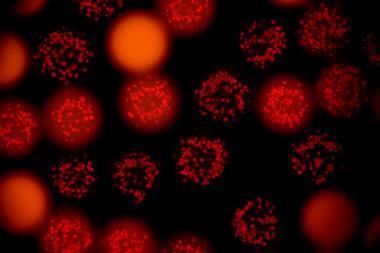Chemists in the UK have developed a new artificial system that mimics biological transmembrane signalling. Using a membrane-anchored molecule in the phospholipid bilayer of a synthetic cell as a sensor, a redox signal outside the cell can generate an amplified fluorescent response inside it.
Transmembrane signal transduction is a process that communicates an extracellular signal across a cell membrane, causing an intracellular response. Signal transduction is ubiquitous in nature and plays an essential role in many biological systems. Typically, a cell-bound protein acts as a receptor that upon recognising a stimulus, transduces the signal inside the cell. Often the signal will activate numerous effectors, amplifying the original signal.
Replicating transmembrane signal transduction in artificial systems has been a long-standing challenge in the scientific community. Early solutions involved transporting ions across cell membranes by clothing them in membrane-permeable cages, or by creating artificial channels that act as a passageway through the membrane. However, amplifying an intracellular response without physically transporting external chemicals across the membrane is a lot more challenging. ‘The idea is to tell the inside of a cell what is happening in the outside environment, but without letting anything from the external environment into the inside of the cell,’ explains Christopher Hunter from the University of Cambridge. ‘These features, separation of input and output together with signal amplification, are a key part of information processing in biological systems.’

Scientists have developed various artificial signal transductions systems in response to this challenge, but a breakthrough from Hunter’s research group is the first to use an external redox signal. Their new system features vesicles with a membrane-anchored transducer molecule that consists of two steroid-linked headgroups. Crucially, this molecule is shorter than the thickness of the lipid bilayer, meaning the internal headgroup cannot be inside the vesicle whilst the external headgroup is outside the vesicle, and vice versa. The two headgroups can each bind to a different type of metal ion, but because the tranducer molecule is too short to span the entire bilayer, only one headgroup can bind a metal ion at a time – this creates an on/off switch.
In the off state, the external headgroup binds to copper ions outside of the vesicle. This copper is in the +2 oxidation state and its strong binding to the external headgroup holds the transducer molecule in position. To turn on the system you must introduce a signal. Sodium ascorbate – more commonly known as vitamin C – is added to the extracellular environment. It acts a source of electrons, reducing copper from the +2 to the +1 oxidation state. The reduced copper binds less favourably to the external headgroup, so the transducer molecule can now move freely across the bilayer. When the internal headgroup reaches the inside of the vesicle it binds to cadmium ions, once bound, the system is in the on state. The resulting cadmium complex catalyses the hydrolysis of an ester substrate inside the vesicle to give a fluorescent product. So, the transducer molecule communicates the addition of vitamin C outside the cell, producing a fluorescent signal inside the cell. Moreover, because the cadmium complex is a catalyst, it can hydrolyse multiple ester substrates, so it amplifies the signal much like in biological systems. To turn the switch off again, one simply adds more copper (II) to the system, which pulls the transducer molecule back into the external position and deactivates the cadmium catalyst.
Under control
The approach of using a transducer molecule that can move across the membrane is inspired by nature, but unique to synthetic systems. ‘Biological systems provide important clues to the kind of nanotechnology that works and that we might achieve with synthetic systems. The first signalling systems … were a direct copy of the signalling proteins used in biology … but the synthetic systems were hard to characterise and to control,’ says Hunter. ‘This method does not require membrane-spanning molecules, but uses movement of a transducer molecule across the bilayer membrane, which turns out to be much easier to control.’
‘[What] is remarkable about this system is the use of an oxidant trigger. It’s a simple but subtly important control feature: a reversible redox signal promotes chemically unrelated esterase-like catalytic function inside an artificial cell,’ comments Jonathan Clayden, an expert on molecular communication devices at the University of Bristol, UK. ‘It opens up the possibility of building biologically orthogonal signalling systems running parallel to those inherent to living cells.’
Thomas Schrader, who researches ways to control biological processes with artificial receptors at the University of Duisburg–Essen in Germany, hopes the work will motivate more chemists to contribute to this area. ‘Although the field of artificial signal transduction is still in its infancy, it bears a high potential for fascinating biological experiments – with the ultimate goal of communicating with living cells.’
By adding redox switching to the growing arsenal of signalling mechanisms, the Hunter research group hope to develop future systems where different cells can respond to different orthogonal inputs.
References
This article is open access
L Trevisan, I Kocsis and CA Hunter, Chem. Commun., 2021, DOI: 10.1039/d0cc08322d












No comments yet